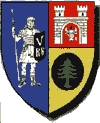Sântimbru (Hungarian: Marosszentimre; German: Sankt Emmerich) is a commune located in Alba County, Transylvania, Romania. It has a population of 3,032 as of 2021, and is composed of five villages: Coșlariu (Koslárd), Dumitra (Demeterpataka), Galtiu (Gáldtő), Sântimbru, and Totoi (Táté).
The commune is situated on the Transylvanian Plateau, at an altitude of 216 m (709 ft). It lies on the banks of the river Mureș; the river Galda flows into the Mureș in Sântimbru.
Following the Mongol invasion of Europe, Transylvanian Saxons settled in Sântimbru in the 13th century. Driven out by the Ottomans in the 16th century, they were replaced by Hungarians, who practised woodcutting. Ethnic Romanians have been in the majority since the 19th century, and today, the inhabitants mainly build bricks and raise poultry.[citation needed]
The village of Totoi has developed a speech form known as Totoiana which consists in the inversion of Romanian words so that other speakers of normal Romanian cannot understand it. It is unique to the village, and it is not spoken in other parts of Sântimbru.[2][3][4]
Points of interest
The commune has a Hungarian Reformed church founded by John Hunyadi in 1449.
Natives
- Samoilă Mârza (1886–1967), photographer
- Andrei Socaci (born 1966), weightlifter
References
- ^ "Populaţia rezidentă după grupa de vârstă, pe județe și municipii, orașe, comune, la 1 decembrie 2021" (XLS). National Institute of Statistics.
- ^ "În localitatea Totoi, județul Alba, se vorbește o limbă specifică locului". Realitatea TV (in Romanian). 19 January 2009.
- ^ Arsenie, Dan (9 December 2011). "Totoiana – messengerul de pe uliță. Povestea unei limbi inventate de români". GreatNews.ro (in Romanian).
- ^ ""Limba intoarsă" vorbită în Totoi". Ziare.com (in Romanian). 2 November 2009.






Recent Comments